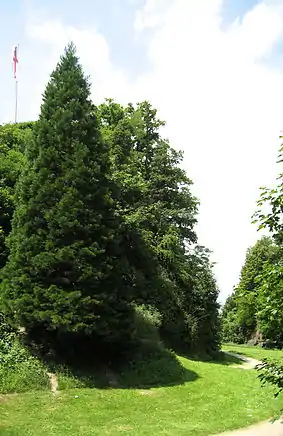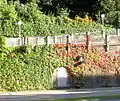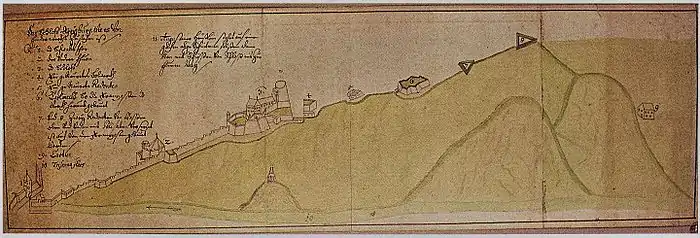Freiburg Castle
Freiburg Castle is a vanished castle. When it existed it was usually called the Burghaldenschloss (motte-and-bailey castle).
| Freiburg Castle on the Schlossberg | |
|---|---|
.jpg.webp) The motte-and-bailey castle in the Topographia Germaniae by Matthäus Merian | |
| Highest point | |
| Elevation | 376.3 m (1,235 ft) |
| Coordinates | 47°59′37.4″N 7°51′29.5″E |
| Geography | |
 Freiburg Castle on the Schlossberg The location within Baden-Württemberg | |
| Location | Baden-Württemberg, Germany |
| Parent range | Black Forest |
Location
It stood on the Schlossberg (castle hill) above the city of Freiburg in Baden-Württemberg. The location was at 376.3 m (1,235 ft) above sea level around an elevation which today is called Ludwigshöhe. Beneath the Ludwigshöhe Roman stone mosaics were found in 1819. The remains of a Roman villa or fortress suggest that the mountain must already have been of strategic importance during the time of the Roman settlement of the Rhine Valley.
History

House of Zähringen
Already in 1091 the duke Berthold II of Zähringen ordered the construction of the Castrum de Friburch on the Schlossberg (castle hill) of Freiburg in beautiful Romanesque style. This castle was praised later by the poet Hartmann von Aue. The Duke's servants and craftsmen lived at the foot of the mountain in the area of what today is the southern part of the historic center, but it was only in 1120 when his son Konrad, with the approval of emperor Henry IV, granted the settlement market rights, thus ending the startup phase of Freiburg.
The existence of the castle is proved at least since 1146 when Bernhard of Clairvaux described in his travel diaries how he healed a blind boy apud castrum Frieburg (at the fort Freiburg). [1] To distinguish it from Zähringen castle above the village of the same name north of Freiburg this castle was called the Burghaldenschloss (motte-and-bailey castle). Throughout history, fires and acts of war on several occasions destroyed the fortified buildings on castle hill, but the castle was rebuilt various times by the respective rulers because of its strategic importance for the protection of Freiburg and to control the access to the Black Forest and the Dreisam valley.
Counts of Freiburg
After the end of the Zähringer in 1218 the dominion of the city Freiburg went over to the counts of Urach who from then on called themselves counts of Freiburg and resided in the castle above Freiburg. The relationship between the citizen and their lords was often disturbed by disputes regarding the financial obligations of the city. Twice the citizens of Freiburg occupied the castle. In the war against their ruler count Egino II and his brother-in-law, the bishop of Strasbourg Konrad von Lichtenberg, in 1299 they used catapults against the castle for the purpose of blowing a breach. When Count Egino III. 1366 tried to enter with his legions in the city at night it came to the war in which the citizens of Freiburg devastated with canons the "most beautiful castle in the German lands". Thereupon the relationship between the ruling counts of Freiburg and the city was completely shattered.
House of Habsburg
The citizens ransomed themselves from their former rulers, the counts of Freiburg, with a lump-sum payment of 15,000 silver marks and submitted themselves voluntarily to the protection of the house of Habsburg in 1368. Generously the new ruler, Leopold III, Duke of Austria, handed the ruins of the castle over to the Freiburgers. The city repaired the fortifications just provisionally so that the castle could be taken easily by the enemy in the German Peasants' War in 1525 as well as in the Thirty Years' War.
Leopoldsburg (Leopold's castle)
Later emperor Leopold I built a mountain fortification including the motte-and-bailey castle in 1668, the "Leopoldsburg", as a bulwark in defense of the threat to the Breisgau imposed by Louis XIV of France.
Dutch War
Nevertheless, already in 1677 during the Dutch War, the French conquered city and fortress. When in 1679 following the treaties of Nijmegen the Habsburgers had to cede Freiburg to the crown of France the Schlossberg experienced its greatest changes.
Vauban's fortification
Louis XIV instructed his military engineer Sébastien Le Prestre de Vauban to fortify the city of Freiburg including the Schlossberg with the Vieux Châteaux (French for: "old castle") in accordance with modern requirements and standards as a French outpost in Further Austria and had it surrounded with a fortress ring along the slope. In 1681, the king himself came to Freiburg with a large entourage to inspect the construction works and also visited the castle.
War of the Palatine Succession
After the war of the Palatine Succession, in the treaty of Ryswick in 1697, Louis XIV had to give up Freiburg. This negative result for the crown of France was glossed over in a French memorandum as follows: The King has given up some places which were not useful for him... Freiburg was not useful enough for the king to perceive its return as a loss, it has returned to be in the bosom of the empire and the care of the emperor, who is also its prince. [2]
War of the Spanish Succession
In the War of the Spanish Succession, the fortress occupied with a strong Austrian garrison was beleaguered and taken again by French troops under Marshal Louis Hector de Villars. In Rastatt the return of the fortress to Germany was agreed upon, which happened in 1715.
War of the Austrian Succession
Afterwards again war broke out, that time the war of the Austrian Succession. In autumn 1744, the French again occupied Freiburg as allies of Frederick the Great, king of Prussia. Louis XV of France observed personally from the Lorettoberg the progress made in the siege of the city and was nearly hit by a stray cannonball of the defenders. One year later, in the treaty of Dresden, Freiburg was returned to the Habsburgers. However, before the French left the city they destroyed Vauban's fortifications practically completely so that of the former castle (whose main component was a donjon shown on illustrations) only a debris cone and the neck ditch remained. As a consequence of the extensive destructions of the castle and the fortifications surrounding the city a vast field of ruins covered the hill and the city for the following decades.
Historic illustrations
 The castle around 1500
The castle around 1500.png.webp) 1549 (castle on the right)
1549 (castle on the right).jpg.webp) 1589 (Schlossberg with castle above the cathedral)
1589 (Schlossberg with castle above the cathedral) 1610 (castle on the right)
1610 (castle on the right) 1644 (Schlossberg with castle above the cathedral)
1644 (Schlossberg with castle above the cathedral) The castle 1678-1745
The castle 1678-1745 Lower castle 1713
Lower castle 1713 View from the Schlossberg 1852
View from the Schlossberg 1852
Historic maps
 1638
1638 1678
1678 1694
1694 1698
1698 1713
1713
.jpg.webp) around 1730
around 1730 Map of the castle and the fortifications 1744
Map of the castle and the fortifications 1744 Installation of batteries above the covered ways 1744
Installation of batteries above the covered ways 1744 Cross-section of the Bastion St. Pierre on the top of the Schlossberg 1745
Cross-section of the Bastion St. Pierre on the top of the Schlossberg 1745
Today
 Schlossberg on the right.
Schlossberg on the right. View from the Schlossberg.
View from the Schlossberg. Ludwigshöhe (to its left the neck ditch).
Ludwigshöhe (to its left the neck ditch). Ludwigshöhe. Its top is a good viewpoint.
Ludwigshöhe. Its top is a good viewpoint. The Bismarck tower on the Schlossberg, built 1900.
The Bismarck tower on the Schlossberg, built 1900. Schlossberg tower, built 2002.
Schlossberg tower, built 2002. Entrance to the shelter at the bottom of the Schlossberg.
Entrance to the shelter at the bottom of the Schlossberg. Vineyard on the slope of the Schlossberg,
Vineyard on the slope of the Schlossberg,
Further reading
- Arthur Hauptmann: Burgen einst und jetzt. Burgen und Burgruinen in Südbaden und angrenzenden Gebieten (Castles then and now. Castles and castle ruins in South Baden and adjacent areas). Publisher: Südkurier, Constance 1987. ISBN 3-87799-040-1
- Hans Schadeck: Burg und Stadtbefestigung von Freiburg bis zum Ende des 16. Jahrhunderts in Stadt und Festung Freiburg (Castle and fortifications of Freiburg until the end of the 16th century in the town and fortress of Freiburg), Publisher: Stadtarchiv Freiburg im Breisgau, 1988
References
1.↑ Hans Schadeck,Burg und Stadtbefestigung von Freiburg bis zum Ende des 16. Jahrhunderts (Castle and fortifications of Freiburg until the end of the 16th century), page 9, in Stadt und Festung Freiburg, published by Stadtarchiv Freiburg im Breisgau, 1988
2.↑ Hermann Kopf, Unter der Krone Frankreichs, (Under the crown of France) Freiburg im Breisgau 1677-1697, Schauinsland 88, 23 1970
